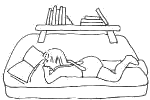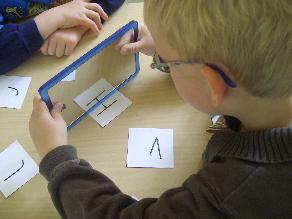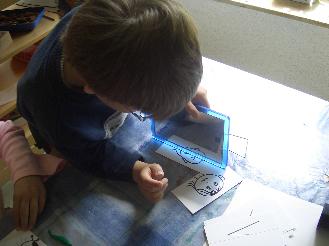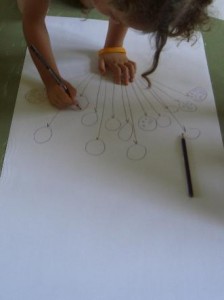by Klaudia Kruszynski
Among the most popular children’s games are those that have to do with sorting, ordering, counting.
This preference can be explained by the development of the intellect. It can be observed in all children in kindergarten, although it is differently developed and advanced in different children.
Children use different objects for this purpose.
As an example, I can mention: sorting magnetic letters by colour or arranging them into two groups: Letters and numbers. Something similar happens with the plug-in games or bead chains.
If the children don’t feel like drawing, they sort the pencils by colour, length or whether they need to be sharpened or not.
In the circle of chairs, the children can tell if everyone is there without counting, without knowing how many are there. They recognise it by the fact that all the chairs are occupied. (One child is assigned to each chair.) Another relation is: There are many toothbrush cups in the washroom – each child has its own. But there is only one tube of toothpaste – it belongs to all the children.
Many party games make use of this preference. They are designed in such a way that the colour rolled is assigned a tile/pin/doll/field. These games are played by the youngest children until they recognise them as too simple and no longer want to play, or they come up with their own variations. For example, the game pieces are no longer placed, but stacked to form a pyramid. This is more difficult than going forward by colour. Some kindergartens don’t like to see this misuse because they are convinced that board games are good for learning rules. If you don’t follow the rules, you won’t be able to find your way in society later on.
I am convinced that people need a regulated world, of course, but a certain independence and flexibility are very desirable. They are, after all, the necessary prerequisite for further development and progress. A certain independence from rules, order structures, procedures, etc. indicates creativity.
Sorting
As I mentioned at the beginning, many children have a preference, even an urge, to sort the objects around them. To do this, it is necessary to perceive one property (later several properties) of the object, and to recognise it in the other objects.
Examples with magnetic letters:
-
- Put all letters of the same colour together,
- Separate letters and numbers from each other,
- Put all letters together, regardless of their colour,
- Pick out all the letters that are in my name,
- Choose the letter you want from the set,
- Arrange the letters according to the alphabet (alphabet according to a template, e.g. from a book, or from memory, e.g. according to a song: „A, B, C, D, E, F, G…“),
- Counting the letters together,
- Compare the amount of the same letters: there are 5 times „A“, but only 2 times „X“,
- Recognise the small „x“ as a „paint sign“, look for the other operation signs,
- Arrange the numbers in ascending order,
- Lay simple operations, for example 2 + 2 = 4,
- Laying patterns.
Mirror images, symmetry
Some objects have a special property: they consist of two identical parts, e.g. the wings of a butterfly, but they are mirror-inverted next to each other. Some objects can be divided into two halves with an imaginary line, which are also mirror-inverted, e.g. a top hat.
Some letters also have this property:
– A, B, C, D, E, H, I, K, M, O, T, U, V, W, X, Y.
With the help of a mirror, children can explore it wonderfully.
I have developed a game for this:
On the small cards, the letters mentioned above are shown individually. In addition, there are the same amount of cards with only halves of letters on them. The so-called „mirror line“ is also painted on these cards. The mirror is placed on it and with its help you can see the whole letter. There are different ways to play with the cards:
-
- Recognise and name the letters,
- Recognise and name the halves of the letters,
- With the help of the mirror, match the „half“ to the correct letter,
- Match the „half“ to the correct letter without the mirror.
Geometric figures can also be divided into equal halves.
Some with only one mirror line – an isosceles triangle,
some with two mirror lines – a rectangle,
some with three lines – an equiangular triangle,
some with an infinite number – a circle.
Finding this out could become an interesting game of discovery.
The circle is a special shape, it is very popular with children because you need it to draw a face or the sun. The circle is, after the cross, the next shape that occurs in the children’s representational development. At the beginning it resembles a spiral, then the children manage to close it. It takes on different shapes: Oval, egg, ellipse, until it finally gets the perfect shape. In all their attempts to paint the circle perfectly, children realise that it is not an easy task. Some children ask adults for help: „Can you paint the circle for me?“ – because they have found that their results are very far from their inner idea of what a real circle should look like. Other children look for objects to help them paint around. (The ability to recognise the circle is a necessary prerequisite for this).
So it often happens with us that the children fetch a plate from the cupboard when they want to paint a mandala. The wheels for self-made cars also have to be real circles – for this, children take the circle from the logical blocks, for example.
I thought of a game for the circle:
Bend the circle, count the parts
There are children of different ages sitting at the table, some can already write numbers, some not yet.
At the beginning, each player draws a circle with the help of the plate, then cuts it out. On another sheet of paper is a simple table. It has two columns: one for the number of kinks and one for the number of parts counted.
Then the circle is folded once and opened again – the children count the kinks (1) and write the number in the corresponding column of the table. Then they count the parts that have been created (2) and also write the number in the correct column.
The younger children draw lines instead of numbers.
The game is continued in this way: 2 kinks – 4 parts, 3 kinks – 6 parts, etc.
After the fifth kink, I asked children if they already knew the result without counting the parts.
Jan, (4 years 7 months) immediately knew the right number, he only counted the parts to check, then he filled in the table without bending the circle any further. He told me: the kinks always go on by „one“, but the parts make a jump over the next number.

Simon also illustrated this phenomenon graphically.
Lukas (5 years 1 month) also had no problems with this task, although he could not explain it so accurately.
Linea (4 years 8 months) wanted to play it safe and didn’t dare make any predictions.
The youngest child (4 years 1 month), of course, had enough trouble with counting the parts created and drawing the lines in the appropriate number. Nevertheless, the child was able to solve the task correctly and to his own complete satisfaction.
This task also involves doubling the number, but the children involved in the game still lack this experience.
To gain such experience, our mirror is wonderfully suitable.
With the mirror you can double everything: the shapes and the quantities. There are many ways to explore this.
Other mirror games
1. the halves of different objects are painted on small cards. Children look at these with the help of the mirror, experiencing the „miracle“ of completion.
2. the same cards are looked at without the mirror. Children guess which object they represent half of.
3. Faces that consist of two different halves are sometimes a man’s face, sometimes a woman’s face.
4. children draw the reflection in the mirror (with and without the help of the mirror).
5. children design their own cards. (To do this, they have to combine knowledge about reflections with their own creativity).
6. Children look at different objects with the mirror and notice that they get different pictures when they change the position of the mirror just a little.
7. After they have understood the phenomenon, they create „mirror patterns“, e.g. in the „hammer game“.
Set theory and statistics in kindergarten.
In the course of life, children develop the urge to sort the things that surround them. Clothes in their favourite colour are picked out from the cupboard, the red cup is placed on a red saucer, each row in the peg game is placed in only one colour, the logical blocks are put away according to shape, the coins are stacked according to colour, later according to value, and so on.
Specific game offers also promote this development, e.g. in the chair circle: Shortly before 12 o’clock, the children collect their kindergarten bags. To avoid chaos, we indicate which children should leave now: all those who have a red jumper on, or all those who have letters on their T-shirt, or who have a pigtail, and so on. Here, a child always feels that he or she belongs to a certain group (crowd), depending on what she or he is wearing that day.
The boring tidying up can also be made more exciting by providing extra bins for toys of different colours, shapes or sizes.
To do this, I thought of a few new games that I did with a small group.
Duplo Man House
20 Duplo men want to „live“ in a house. They are all different and they don’t want to be in one room. The „girls“ don’t want to live with the „boys“. The ones with red jumpers don’t want to share their room with the ones with blue jumpers, etc.
This game developed like a story (other variations would have been possible, of course).
Children looked at the little dolls and thought about which room they should put them in. They counted the quantities and wrote down the numbers. Some dolls could be assigned to several rooms.
Through precise instructions that were on the „playing cards“, all the children present were able to complete the allocation, the older ones did the writing down of the numbers.
Statistical investigation of the Duplo society
This time we wanted to take a closer look at the Duplo men, each one individually. I chose the most important criteria and prepared a statistical table. This task demanded much more attention, concentration and perseverance from the children.
To my amazement, this game became the favourite activity of several children, even younger ones.
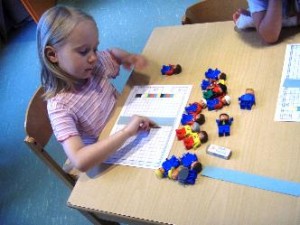
I observed how lovingly and at the same time perceptively the little dolls were looked at by the children, how the crosses were made in the corresponding columns. (Some children didn’t need „help strips“ for this, they could locate the coordinates correctly).
One day Jan (4 years, 7 months) approached me and said he would like to prepare such a table for the children.
I thought that was a good idea, and together we thought that this time we would investigate Duplo animals.
Jan chose 10 animals from the Duplo animal box. We looked at them and thought about which criteria we could take. Jan drew the chart, but he asked me to write it on the computer because it would be much nicer (unfortunately, we don’t have a computer in the kindergarten for such games – it would be very exciting to let Jan prepare the chart).
This task was also solved with enthusiasm by several children, although Jan personally did not attach much importance to solving it correctly, he made a lot of mistakes.
Finally, Lukas did a final calculation to check who had solved the task most accurately. For this, he had to enter all the individual results and then compare them with the correct number. He worked very persistently and concentrated.
Potency
In spring, we looked at the growth of plants. We observed for several weeks how the bean seeds germinated, grew into green plants and produced flowers. Finally, we could see the pods with new seeds forming and ripening. In the first week of September it was harvest time.
There were 6 plants in the flower pot, each with 3 pods.
I worked with a small group consisting of the children who had taken care of the bean plants during the growing season.
Each child was given a large sheet of paper, a pencil and of course a harvested plant.
At the beginning the children looked at the plants, we remembered what we had observed in spring:
What was the growth like, what did the plants need to grow properly, etc.
We also noticed that each plant grew from a single bean.
The children were already very excited to see the pods, which they finally opened. They were very amazed when they discovered the white seeds inside.
Each child was asked to count their „bean children“ and write down the number. The quantities were 14 or 15 seeds. I asked the question, „How many children did the bean mama get?“ Each child gave me the answer.
Then we added up all the „children“: 88.
I asked if they knew how many children these beans would have when we put them in the ground next spring?
The children couldn’t imagine, they gave me different answers.
I drew a bean on the sheet – it was the „bean mother“, below it all 15 „child beans“.
For each „child“ I drew their children (if we were to put this bean in the ground next year).
The children supported me in painting and noticed that there would be a lot of new beans.
And if we put these „grandchildren’s beans“ into the soil, we will get very, very many beans.
In this offering, it was not important to learn exactly the true nature of mathematical power. It was important that the children developed a feeling for it.
To do this, I came up with a story:
A garden gnome called Bodo was very fond of bean stew. That’s why he put a bean seed in the ground in spring. He made sure that the seed got everything for its development: good soil, water, light and warmth. He watched his plant develop magnificently. The neighbours also supported him.
When the summer ended, the harvest came. Bodo proudly opened the 3 yellow pods and put 15 white, smooth seeds in the basket. On Sunday he wanted to cook bean stew and invite the nice neighbours over.
„You don’t just need beans for a tasty bean stew,“ Bodo thought, „you also need potatoes, leeks and carrots. And then pepper and salt. He could get that at the shop of the clever vixen Adele. In return, Adele wanted 5 bean seeds as payment.
And then Bodo had to buy firewood from Felix the beaver. Felix demanded 3 beans for it.
When Bodo came home with his purchases, he found that he only had 7 bean seeds left. It was very little. He thought for a long time and finally put 2 seeds in a little wooden box and said, „I’ll put those in the ground next spring!“
He cooked the last 5 beans with other vegetables. When the neighbours asked why the bean stew hardly tasted like beans, Bodo said, „Come next year for bean stew!“
This story preserves the knowledge about plant development that the children have gathered through active observation. And, of course, quite a lot of mathematics. There are also some elements of economics.
I created a picture book together with children for this story.
This became the conclusion of our bean farm and at the same time our contribution to the theme: „Harvest Festival“.
Every occasion in kindergarten enables us kindergarten teachers to introduce children to the fascinating world of mathematics.
It is about developing the understanding of numbers, quantities, operations, effects and phenomena.
We must not forget that the children have had a variety of experiences in the mathematical field long before they come to kindergarten.
It is not a new world into which we are leading the children, so we should continue to accompany them with naturalness and without fear of incompetence.
It goes without saying that kindergarten is not a place for the tedious practice of „writing numbers“. That is already the responsibility of the school. Everything else can develop into a wonderful adventure.
See also:
The Advancement of Mathematical Talent in Kindergarten
Date of publication in German: 2009, August
Copyright © Klaudia Kruszynski, see imprint.
